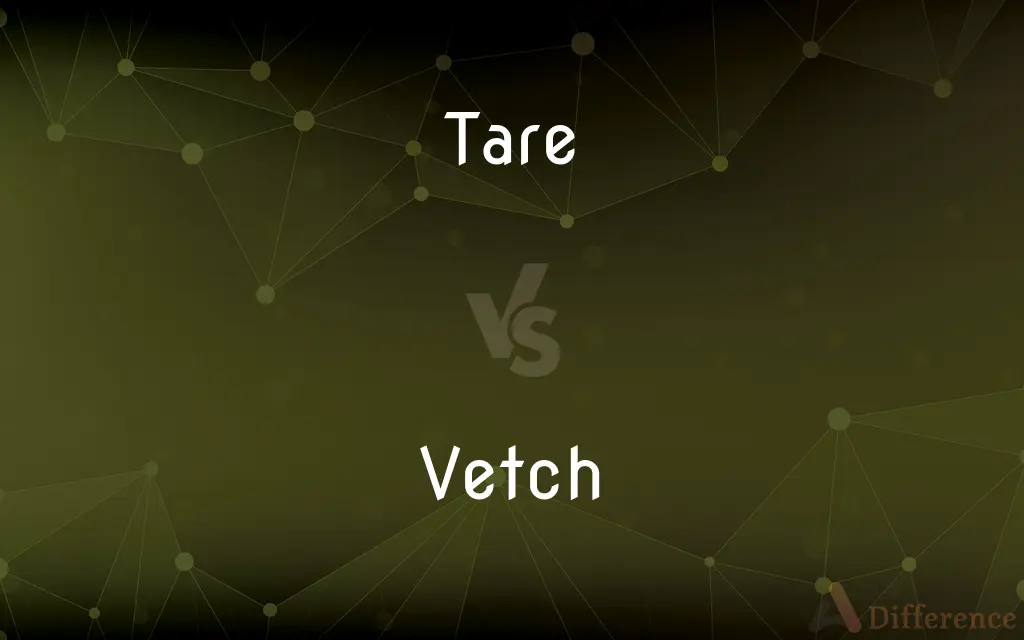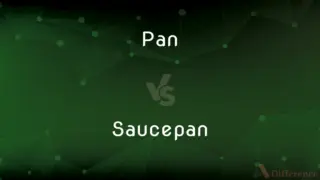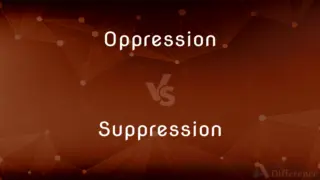Tare vs. Vetch — What's the Difference?
By Tayyaba Rehman & Maham Liaqat — Updated on April 27, 2024
Tare refers to a type of weed commonly found in grain crops, while vetch is a leguminous plant used as fodder and for soil improvement.

Difference Between Tare and Vetch
Table of Contents
ADVERTISEMENT
Key Differences
Tare, often mentioned in agricultural contexts, is considered a weed that competes with crops for resources. Whereas vetch is valued in agriculture for its ability to fix nitrogen in the soil, enhancing fertility.
Tare usually grows unintentionally among cereal crops like wheat and barley, presenting a challenge for farmers. On the other hand, vetch is intentionally sown in fields, either as a cover crop or mixed with other forages to benefit livestock.
While tare is typically removed from fields to protect the yield and quality of the main crop, vetch is harvested or left to decompose, contributing organic matter and nutrients back into the earth.
Farmers often struggle with tare because it can significantly reduce crop yields if not controlled. Conversely, vetch is often used in crop rotation systems to naturally replenish soil nutrients, reducing the need for chemical fertilizers.
In terms of economic impact, tare is mostly seen as a nuisance that incurs additional costs for removal. In contrast, vetch can be a source of profit, whether sold as fodder or used to improve subsequent crop yields through its soil-enhancing properties.
ADVERTISEMENT
Comparison Chart
Classification
Weed
Legume
Agricultural Use
Removed to protect crop yields
Planted for soil fertility and fodder
Growth
Unintentional
Intentional
Economic Impact
Incurs costs for removal
Can increase profitability of soil and crops
Benefit to Soil
Generally none
Improves soil nitrogen content
Compare with Definitions
Tare
A nuisance in agriculture.
Controlling tare is crucial for a good harvest.
Vetch
Planted to improve soil health.
Vetch is great for fixing nitrogen in the fields.
Tare
Weed found in cereal crops.
Farmers often find tare growing among their wheat.
Vetch
Often used in green manure cropping.
The farmer used vetch as a cover crop this season.
Tare
A deduction from the gross weight to find net weight.
The tare weight was subtracted at the shipping point.
Vetch
A climbing legume used as fodder.
They planted vetch to feed the cattle through winter.
Tare
The empty weight of a container.
They calculated the tare of the empty trucks.
Vetch
Valuable for sustainable farming.
Vetch supports biodiversity in cropping systems.
Tare
Biblical reference to unwanted plants.
The parable speaks of sowing tare among the wheat.
Vetch
A component in pasture mixes.
Vetch mixed with ryegrass provides excellent forage.
Tare
Any of several vetches native to Europe.
Vetch
Any of various herbs of the genus Vicia of the pea family, having pinnately compound leaves that terminate in tendrils and small, variously colored flowers.
Tare
Any of several weedy plants that grow in grain fields.
Vetch
Any of several leguminous plants, of the genus Vicia, often grown as green manure and for their edible seeds.
Tare
Tares An unwelcome or objectionable element.
Vetch
Any of several similar plants within the subfamily Faboideae.
Tare
The weight of a container or wrapper that is deducted from the gross weight to obtain net weight.
Vetch
Any leguminous plant of the genus Vicia, some species of which are valuable for fodder. The common species is Vicia sativa.
Tare
A deduction from gross weight made to allow for the weight of a container.
Vetch
Any of various climbing plants of the genus Vicia having pinnately compound leaves that terminate in tendrils and small variously colored flowers; includes valuable forage and soil-building plants
Tare
(Chemistry) A counterbalance, especially an empty vessel used to counterbalance the weight of a similar container.
Tare
To determine or indicate the tare of, especially to weigh in order to find out the tare.
Tare
(rare) A vetch, or the seed of a vetch (genus Vicia, esp. Vicia sativa)
Tare
Any of the tufted grasses of genus Lolium; darnel.
Tare
A damaging weed growing in fields of grain.
Tare
The empty weight of a container; the tare weight or unladen weight.
Tare
Any of various dipping sauces served with Japanese food, typically based on soy sauce.
Tare
To take into account the weight of the container, wrapping etc. in weighting merchandise.
Tare
(sciences) To set a zero value on an instrument (usually a balance) that discounts the starting point.
Tare
(obsolete) tear
Tare
Tore.
Tare
A weed that grows among wheat and other grain; - alleged by modern naturalists to be the Lolium temulentum, or darnel.
Didst not thou sow good seed in thy field? From whence then hath it tares?
The "darnel" is said to be the tares of Scripture, and is the only deleterious species belonging to the whole order.
Tare
A name of several climbing or diffuse leguminous herbs of the genus Vicia; especially, the Vicia sativa, sometimes grown for fodder.
Tare
Deficientcy in the weight or quantity of goods by reason of the weight of the cask, bag, or whatever contains the commodity, and is weighed with it; hence, the allowance or abatement of a certain weight or quantity which the seller makes to the buyer on account of the weight of such cask, bag, etc.
Tare
To ascertain or mark the tare of (goods).
Tare
Any of several weedy vetches grown for forage
Tare
Weedy annual grass often occurs in grainfields and other cultivated land; seeds sometimes considered poisonous
Tare
Counterweight consisting of an empty container that is used as a counterbalance to obtain net weight
Common Curiosities
Can tare be beneficial in any way?
Generally, tare is considered a harmful weed with no agricultural benefits.
What is tare typically found with?
Tare is commonly found among cereal crops like wheat and barley.
Why is vetch important in agriculture?
Vetch is important for its nitrogen-fixing ability, improving soil fertility.
Is vetch easy to grow?
Vetch is relatively easy to grow and can thrive in various soil conditions.
What are the typical uses of vetch in farming?
Vetch is used as fodder, in crop rotations, and as a cover crop to improve soil health.
What economic impact does vetch have?
Vetch can increase profitability by enhancing soil and reducing fertilizer costs.
What makes tare a significant problem in agriculture?
Its ability to quickly spread and compete with crops makes it a significant problem.
What crops are typically associated with vetch?
Vetch is often associated with other legumes and grains in crop rotations.
How does vetch benefit the soil?
Vetch enhances soil by adding organic matter and increasing nitrogen content.
What challenges does tare present to farmers?
Tare competes for resources with the main crops, reducing yields.
How do farmers deal with tare?
Farmers remove or control tare to protect their main crop yields.
How is vetch harvested?
Vetch can be harvested as fodder or left in the field as green manure.
Can tare affect crop quality?
Yes, tare can lower the quality of the main crop by its presence.
How can tare be controlled?
Tare control often involves manual removal or the use of herbicides.
Share Your Discovery

Previous Comparison
Pan vs. Saucepan
Next Comparison
Oppression vs. SuppressionAuthor Spotlight
Written by
Tayyaba RehmanTayyaba Rehman is a distinguished writer, currently serving as a primary contributor to askdifference.com. As a researcher in semantics and etymology, Tayyaba's passion for the complexity of languages and their distinctions has found a perfect home on the platform. Tayyaba delves into the intricacies of language, distinguishing between commonly confused words and phrases, thereby providing clarity for readers worldwide.
Co-written by
Maham Liaqat















































